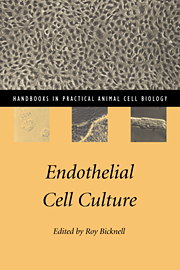Book contents
- Frontmatter
- Contents
- List of Contributors
- Preface to the series
- Acknowledgement
- 1 Introduction to the endothelial cell
- 2 Lung microvascular endothelial cells: defining in vitro models
- 3 Bone marrow endothelium
- 4 Endothelium of the brain
- 5 Isolation, culture and properties of microvessel endothelium from human breast adipose tissue
- 6 Human skin microvascular endothelial cells
- 7 Microvascular endothelium from adipose tissue
- 8 Endothelium of the female reproductive system
- 9 Synovial microvascular endothelial cell isolation and culture
- Index
1 - Introduction to the endothelial cell
Published online by Cambridge University Press: 03 November 2009
- Frontmatter
- Contents
- List of Contributors
- Preface to the series
- Acknowledgement
- 1 Introduction to the endothelial cell
- 2 Lung microvascular endothelial cells: defining in vitro models
- 3 Bone marrow endothelium
- 4 Endothelium of the brain
- 5 Isolation, culture and properties of microvessel endothelium from human breast adipose tissue
- 6 Human skin microvascular endothelial cells
- 7 Microvascular endothelium from adipose tissue
- 8 Endothelium of the female reproductive system
- 9 Synovial microvascular endothelial cell isolation and culture
- Index
Summary
Introduction
For many years the endothelial cell was regarded in medicine and physiology as ‘an inert sac whose function was simply to separate the blood from the tissues’. We now know that the endothelium is an extremely active tissue that plays an intimate role in many physiological processes. Dysfunction of the endothelial cell is a key step in the development of many pathologies including the two major killers of Western man: atherosclerosis (a disease of the larger vessels) and cancer (tumour angiogenesis). As the skill of biologists in the characterisation of the endothelium in vivo and in vitro has increased it has become apparent that there exists extensive endothelial heterogeneity. Thus, the tenet that an endothelial cell is an endothelial cell is an endothelial cell is no longer valid. A corollary of this heterogeneity is that it is imperative to work with an appropriate end othelial isolate when studying the role of endothelium in a given pathology. From this has sprung the increasing interest in the isolation and culture of endothelium from diverse organs.
A remarkable property of endothelium is its quiescence. Thus, in the adult the average endothelial cell divides (approximately) twice in a lifetime. Contrast this with epithelia that divide continually throughout adult life. Nevertheless, when required, endothelial proliferation can be very rapid. Consider a healing wound: endothelial proliferation (as a component of angiogenesis) is switched on, then off, as required and is under exquisite control. In the past I have likened this angiogenesis to the blood clotting cascade. The existing vasculature is a coiled spring poised for angiogenesis should a physiological need arise.
- Type
- Chapter
- Information
- Endothelial Cell Culture , pp. 1 - 6Publisher: Cambridge University PressPrint publication year: 1996
- 1
- Cited by

